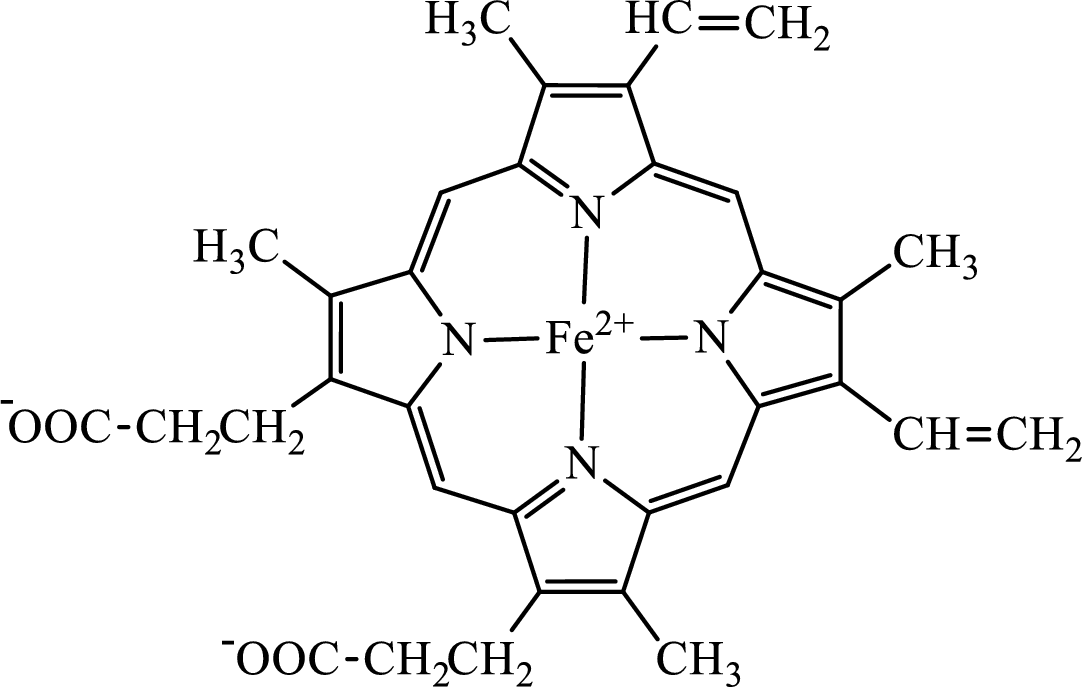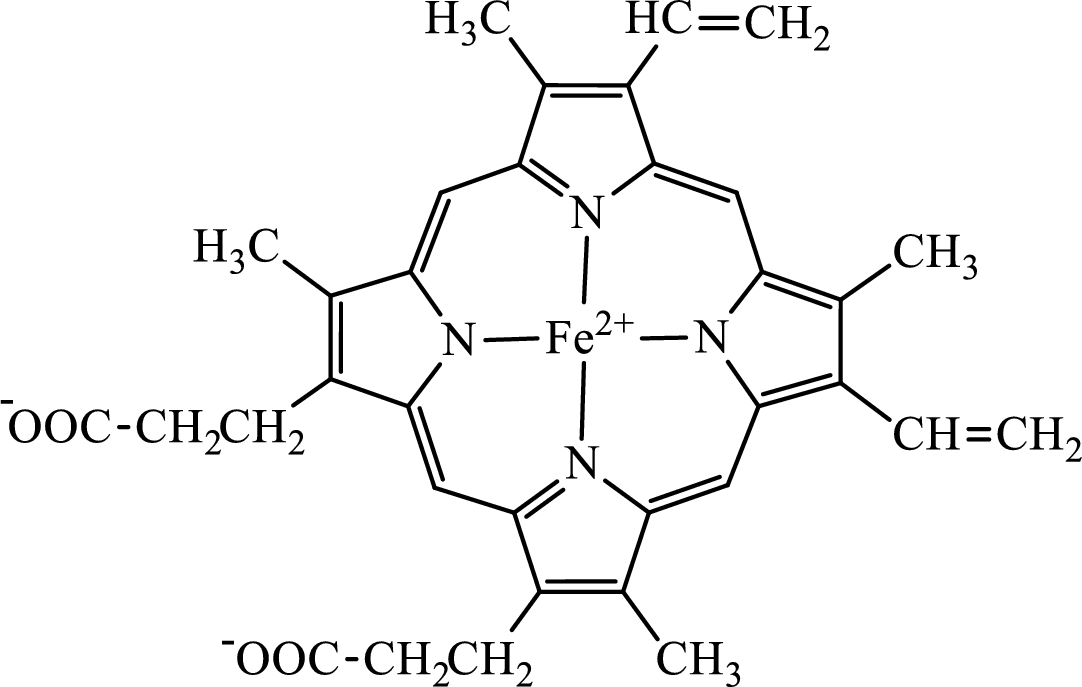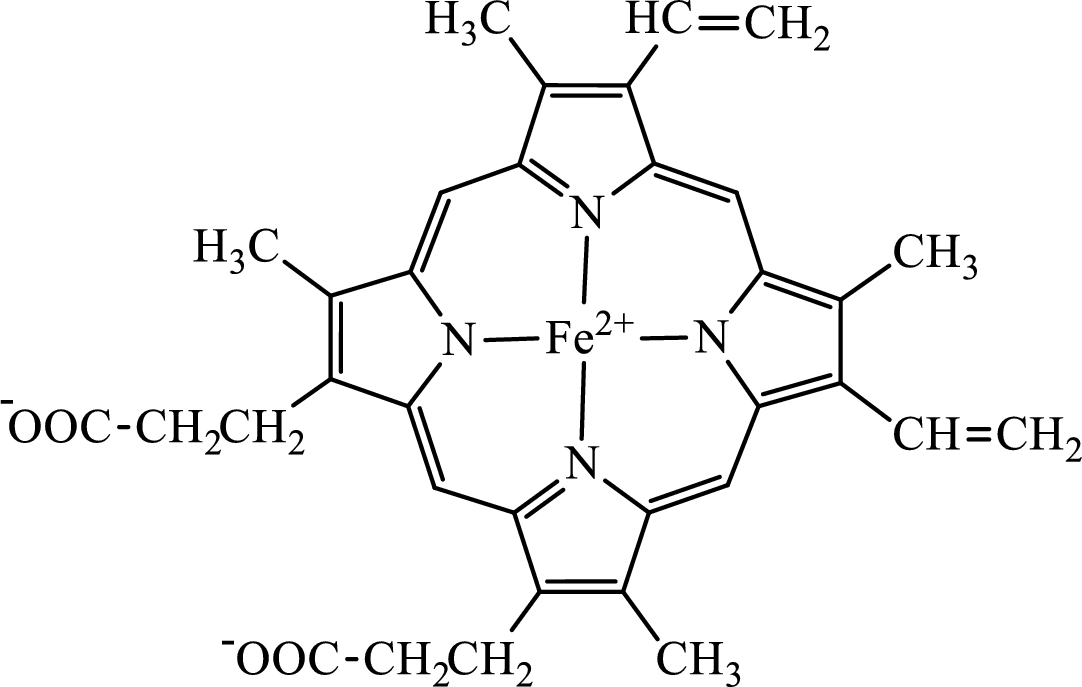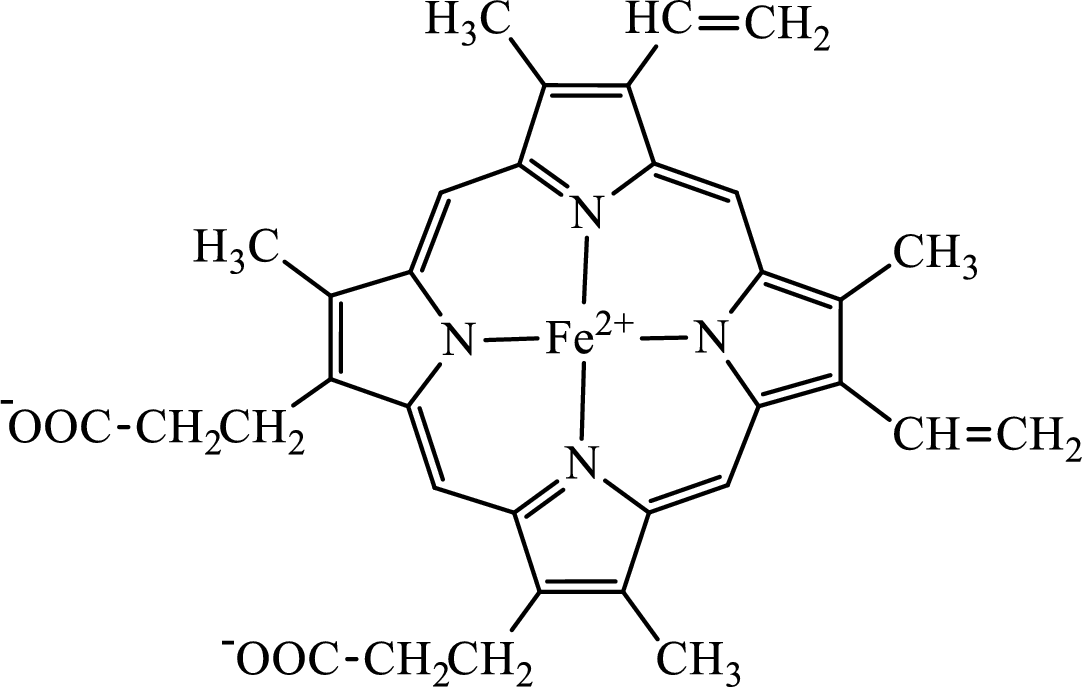
Concept explainers
(a)
Interpretation: To identify the heme degradation product (1) bilirubin, (2) biliverdin, (3) stercobilin, and (4) urobilin in whose production “ring-opening” occurs.
Concept introduction: Hemoglobin is a heme protein present in the red blood cells. The protein part is called globin and the non-protein part is heme. Heme is the prosthetic group that contains 4 pyrrole groups bonded together and has an iron atom in the center. The structure of the heme group is:

The first step of degradation of heme involves opening of pyrrole ring with the release of the iron atom and production of biliverdin. The iron atom released becomes part of ferritin protein. Biliverdin produced is converted bilirubin in the spleen. Bilirubin is then transported to the liver where attachment of sugar residues to the propionate side chains of the bilirubin occurs to make it more soluble. Then more solubilized bilirubin is excreted in bile and finally to the small intestine. In the small intestine, it is converted into stercobilin for excretion in feces or urobilin for excretion in urine.
(b)
Interpretation: To identify the heme degradation product (1) bilirubin, (2) biliverdin, (3) stercobilin, and (4) urobilin in whose production a carbon-carbon double bond is changed to a carbon-carbon single bond.
Concept introduction: Hemoglobin is a heme protein present in the red blood cells. The protein part is called globin and the non-protein part is heme. Heme is the prosthetic group that contains 4 pyrrole groups bonded together and has an iron atom in the center.
The structure of the heme group is:

The first step of degradation of heme involves opening of pyrrole ring with the release of the iron atom and production of biliverdin. The iron atom released becomes part of ferritin protein. Biliverdin produced is converted bilirubin in the spleen. Bilirubin is then transported to the liver where attachment of sugar residues to the propionate side chains of the bilirubin occurs to make it more soluble. Then more solubilized bilirubin is excreted in bile and finally to the small intestine. In the small intestine, it is converted into stercobilin for excretion in feces or urobilin for excretion in urine.
(c)
Interpretation: To identify the heme degradation product (1) bilirubin, (2) biliverdin, (3) stercobilin, and (4) urobilin that is rendered more water soluble by use of a glucose derivative.
Concept introduction: Hemoglobin is a heme protein present in the red blood cells. The protein part is called globin and the non-protein part is heme. Heme is the prosthetic group that contains 4 pyrrole groups bonded together and has an iron atom in the center.
The first step of degradation of heme involves opening of pyrrole ring with the release of the iron atom and production of biliverdin. The iron atom released becomes part of ferritin protein. Biliverdin produced is converted bilirubin in the spleen. Bilirubin is then transported to the liver where attachment of sugar residues to the propionate side chains of the bilirubin occurs to make it more soluble. Then more solubilized bilirubin is excreted in bile and finally to the small intestine. In the small intestine, it is converted into stercobilin for excretion in feces or urobilin for excretion in urine.
The structure of the heme group is:

(d)
Interpretation: To identify the heme degradation product (1) bilirubin, (2) biliverdin, (3) stercobilin, and (4) urobilin which is bile pigment and has a yellowish color.
Concept introduction: Hemoglobin is a heme protein present in the red blood cells. The protein part is called globin and the non-protein part is heme. Heme is the prosthetic group that contains 4 pyrrole groups bonded together and has an iron atom in the center.
The structure of the heme group is:

The first step of degradation of heme involves opening of pyrrole ring with the release of the iron atom and production of biliverdin. The iron atom released becomes part of ferritin protein. Biliverdin produced is converted bilirubin in the spleen. Bilirubin is then transported to the liver where attachment of sugar residues to the propionate side chains of the bilirubin occurs to make it more soluble. Then more solubilized bilirubin is excreted in bile and finally to the small intestine. In the small intestine, it is converted into stercobilin for excretion in feces or urobilin for excretion in urine.
Bile pigments are the colored degradation product of tetrapyrrole carbon arrangement of heme portion of hemoglobin. These are excreted in bile and give characteristic color to urine and feces.
Want to see the full answer?
Check out a sample textbook solution
Chapter 26 Solutions
EBK GENERAL, ORGANIC, AND BIOLOGICAL CH
- For each reaction below, decide if the first stable organic product that forms in solution will create a new CC bond, and check the appropriate box. Next, for each reaction to which you answered "Yes" to in the table, draw this product in the drawing area below. Note for advanced students: for this problem, don't worry if you think this product will continue to react under the current conditions - just focus on the first stable product you expect to form in solution. དྲ。 ✗MgBr ? O CI Will the first product that forms in this reaction create a new C-C bond? Yes No • ? Will the first product that forms in this reaction create a new CC bond? Yes No × : ☐ Xarrow_forwardPredict the major products of this organic reaction: OH NaBH4 H ? CH3OH Note: be sure you use dash and wedge bonds when necessary, for example to distinguish between major products with different stereochemistry. Click and drag to start drawing a structure. ☐ : Sarrow_forwardPredict the major products of this organic reaction: 1. LIAIHA 2. H₂O ? Note: be sure you use dash and wedge bonds when necessary, for example to distinguish between major products with different stereochemistry. Click and drag to start drawing a structure. X : ☐arrow_forward
- For each reaction below, decide if the first stable organic product that forms in solution will create a new C - C bond, and check the appropriate box. Next, for each reaction to which you answered "Yes" to in the table, draw this product in the drawing area below. Note for advanced students: for this problem, don't worry if you think this product will continue to react under the current conditions - just focus on the first stable product you expect to form in solution. NH2 tu ? ? OH Will the first product that forms in this reaction create a new CC bond? Yes No Will the first product that forms in this reaction create a new CC bond? Yes No C $ ©arrow_forwardAs the lead product manager at OrganometALEKS Industries, you are trying to decide if the following reaction will make a molecule with a new C-C bond as its major product: 1. MgCl ? 2. H₂O* If this reaction will work, draw the major organic product or products you would expect in the drawing area below. If there's more than one major product, you can draw them in any arrangement you like. Be sure you use wedge and dash bonds if necessary, for example to distinguish between major products with different stereochemistry. If the major products of this reaction won't have a new CC bond, just check the box under the drawing area and leave it blank. Click and drag to start drawing a structure. This reaction will not make a product with a new CC bond. G marrow_forwardIncluding activity coefficients, find [Hg22+] in saturated Hg2Br2 in 0.00100 M NH4 Ksp Hg2Br2 = 5.6×10-23.arrow_forward
- give example for the following(by equation) a. Converting a water insoluble compound to a soluble one. b. Diazotization reaction form diazonium salt c. coupling reaction of a diazonium salt d. indacator properties of MO e. Diazotization ( diazonium salt of bromobenzene)arrow_forward2-Propanone and ethyllithium are mixed and subsequently acid hydrolyzed. Draw and name the structures of the products.arrow_forward(Methanesulfinyl)methane is reacted with NaH, and then with acetophenone. Draw and name the structures of the products.arrow_forward
- 3-Oxo-butanenitrile and (E)-2-butenal are mixed with sodium ethoxide in ethanol. Draw and name the structures of the products.arrow_forwardWhat is the reason of the following(use equations if possible) a.) In MO preperation through diazotization: Addition of sodium nitrite in acidfied solution in order to form diazonium salt b.) in MO experiment: addition of sodium hydroxide solution in the last step to isolate the product MO. What is the color of MO at low pH c.) In MO experiment: addition of sodium hydroxide solution in the last step to isolate the product MO. What is the color of MO at pH 4.5 d.) Avoiding not cooling down the reaction mixture when preparing the diazonium salt e.) Cbvcarrow_forwardA 0.552-g sample of an unknown acid was dissolved in water to a total volume of 20.0 mL. This sample was titrated with 0.1103 M KOH. The equivalence point occurred at 29.42 mL base added. The pH of the solution at 10.0 mL base added was 3.72. Determine the molar mass of the acid. Determine the Ka of the acid.arrow_forward
 Chemistry for Today: General, Organic, and Bioche...ChemistryISBN:9781305960060Author:Spencer L. Seager, Michael R. Slabaugh, Maren S. HansenPublisher:Cengage Learning
Chemistry for Today: General, Organic, and Bioche...ChemistryISBN:9781305960060Author:Spencer L. Seager, Michael R. Slabaugh, Maren S. HansenPublisher:Cengage Learning General, Organic, and Biological ChemistryChemistryISBN:9781285853918Author:H. Stephen StokerPublisher:Cengage Learning
General, Organic, and Biological ChemistryChemistryISBN:9781285853918Author:H. Stephen StokerPublisher:Cengage Learning Organic And Biological ChemistryChemistryISBN:9781305081079Author:STOKER, H. Stephen (howard Stephen)Publisher:Cengage Learning,
Organic And Biological ChemistryChemistryISBN:9781305081079Author:STOKER, H. Stephen (howard Stephen)Publisher:Cengage Learning, Introduction to General, Organic and BiochemistryChemistryISBN:9781285869759Author:Frederick A. Bettelheim, William H. Brown, Mary K. Campbell, Shawn O. Farrell, Omar TorresPublisher:Cengage Learning
Introduction to General, Organic and BiochemistryChemistryISBN:9781285869759Author:Frederick A. Bettelheim, William H. Brown, Mary K. Campbell, Shawn O. Farrell, Omar TorresPublisher:Cengage Learning



